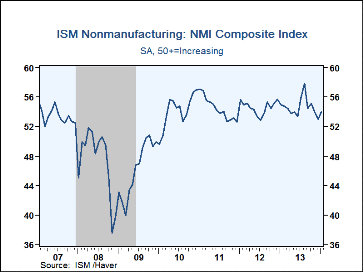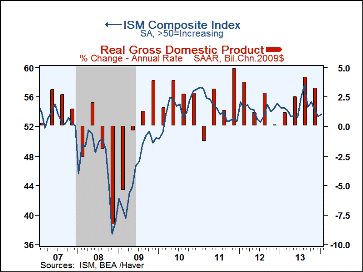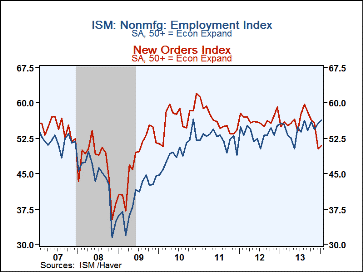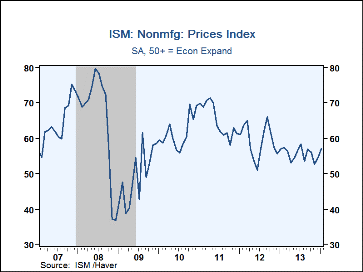 Global| Feb 05 2014
Global| Feb 05 2014U.S. ISM Nonmanufacturing Index Recovers
by:Tom Moeller
|in:Economy in Brief
Summary
The Composite Index for the service and construction sectors from the Institute for Supply Management (ISM) improved during January to 54.0 and recovered December's decline. The latest figure roughly matched expectations for [...]
The Composite Index for the service and construction sectors from the Institute for Supply Management (ISM) improved during January to 54.0 and recovered December's decline. The latest figure roughly matched expectations for improvement to 53.9 in the Action Economics survey. It remained, nevertheless, well below the 57.9 peak reached last August. During the last ten years there has been a 75% correlation between the level of the nonmanufacturing composite index and the q/q change in real GDP for the service and the construction sectors. Recent figures were revised due to new seasonal factors.
Haver Analytics calculates a composite index using the ISM nonmanufacturing series and the ISM manufacturing sector index released Monday. The January figure nudged up to 53.7, but remained near the lowest reading since June. During the last ten years there has been a 76% correlation between the composite index and the quarterly change in real GDP.
The employment component of the ISM series rose to 56.4, the highest level since November 2010 and roughly matched the highest level of the economic expansion. The other component series showed lesser improvements. The business activity index gained to 56.3 but continued in its sideways range throughout the economic recovery. The new orders reading ticked up to 50.9 but remained near the recovery's low. The supplier deliveries series improved to 52.5 and landed near the center of the recovery's range.
The prices paid index gained to 57.1, the highest level in six months. Twenty one percent of respondents indicated higher prices last month while three percent reported them lower. During the last ten years there has been a 78% correlation between the price index and the q/q change in the GDP services chain price index.
Beginning with the January 2008 Nonmanufacturing Report On Business, the composite index is calculated as an indication of overall economic conditions for the non-manufacturing sector. It is a composite index based on the diffusion indices of four of the indicators (business activity, new orders, employment and supplier deliveries) with equal weights. Readings above 50 indicate expansion in activity.
The ISM data are available in Haver's USECON database. The expectations figure from ACTION ECONOMICS is in the AS1REPNA database.
| ISM Nonmanufacturing Survey (SA) | Jan | Dec | Nov | Jan'13 | 2013 | 2012 | 2011 |
|---|---|---|---|---|---|---|---|
| Composite Diffusion Index | 54.0 | 53.0 | 54.1 | 54.9 | 54.7 | 54.6 | 54.4 |
| Business Activity | 56.3 | 54.3 | 55.3 | 56.4 | 56.7 | 57.7 | 57.2 |
| New Orders | 50.9 | 50.4 | 55.7 | 55.0 | 55.9 | 56.6 | 56.3 |
| Employment | 56.4 | 55.6 | 54.5 | 55.6 | 54.4 | 53.5 | 52.4 |
| Supplier Deliveries (NSA) | 52.5 | 51.5 | 51.0 | 52.5 | 51.7 | 50.6 | 51.9 |
| Prices Index | 57.1 | 54.7 | 52.7 | 57.1 | 55.6 | 59.3 | 65.1 |
Tom Moeller
AuthorMore in Author Profile »Prior to joining Haver Analytics in 2000, Mr. Moeller worked as the Economist at Chancellor Capital Management from 1985 to 1999. There, he developed comprehensive economic forecasts and interpreted economic data for equity and fixed income portfolio managers. Also at Chancellor, Mr. Moeller worked as an equity analyst and was responsible for researching and rating companies in the economically sensitive automobile and housing industries for investment in Chancellor’s equity portfolio. Prior to joining Chancellor, Mr. Moeller was an Economist at Citibank from 1979 to 1984. He also analyzed pricing behavior in the metals industry for the Council on Wage and Price Stability in Washington, D.C. In 1999, Mr. Moeller received the award for most accurate forecast from the Forecasters' Club of New York. From 1990 to 1992 he was President of the New York Association for Business Economists. Mr. Moeller earned an M.B.A. in Finance from Fordham University, where he graduated in 1987. He holds a Bachelor of Arts in Economics from George Washington University.










